

Compact Muon Solenoid
LHC, CERN
| CMS-PAS-SUS-19-012 | ||
| Search for electroweak production of charginos and neutralinos in proton-proton collisions at √s= 13 TeV | ||
| CMS Collaboration | ||
| February 2021 | ||
| Abstract: A direct search for electroweak production of charginos and neutralinos is presented. Events with three or more leptons, with up to two hadronically decaying τ leptons, or two leptons of the same charge are analyzed. The data sample consists of 137 fb−1 of proton-proton collisions recorded with the CMS detector at the LHC. The results are interpreted in terms of several simplified models approximating a broad range of production and decay scenarios for charginos and neutralinos. A parametric neural network is used to target several of the models suffering from large backgrounds, while a search using orthogonal search regions is provided for all the models, simplifying alternative theoretical interpretations of the results. Depending on the model hypotheses, chargino and neutralino masses between 1450 GeV and 300 GeV are excluded at 95% confidence level. | ||
|
Links:
CDS record (PDF) ;
CADI line (restricted) ;
These preliminary results are superseded in this paper, Submitted to JHEP. The superseded preliminary plots can be found here. |
||
| Figures | |

png pdf |
Figure 1:
Production of ˜χ±1˜χ02 with subsequent decays through sleptons (left) and sneutrinos (right). |
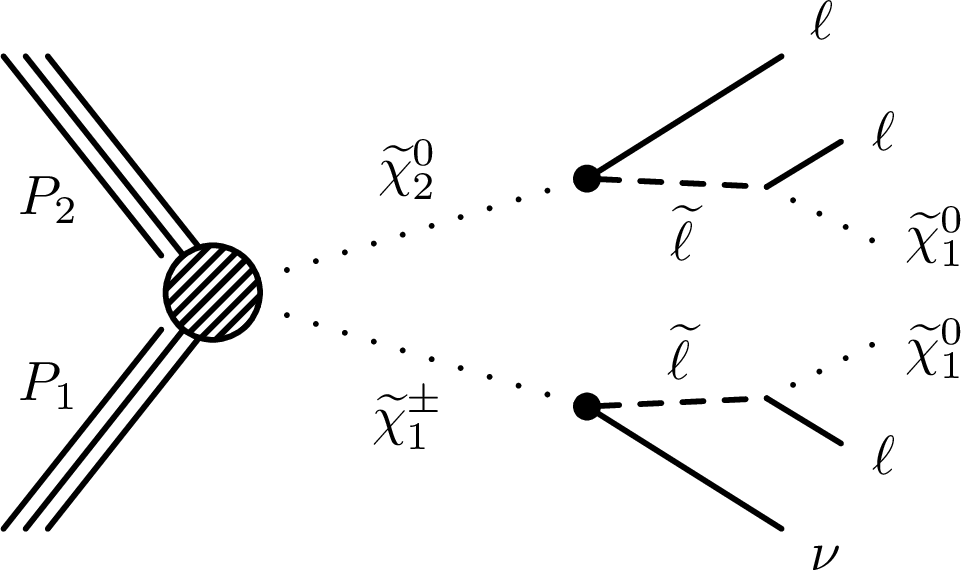
png pdf |
Figure 1-a:
Production of ˜χ±1˜χ02 with subsequent decays through sleptons (left) and sneutrinos (right). |
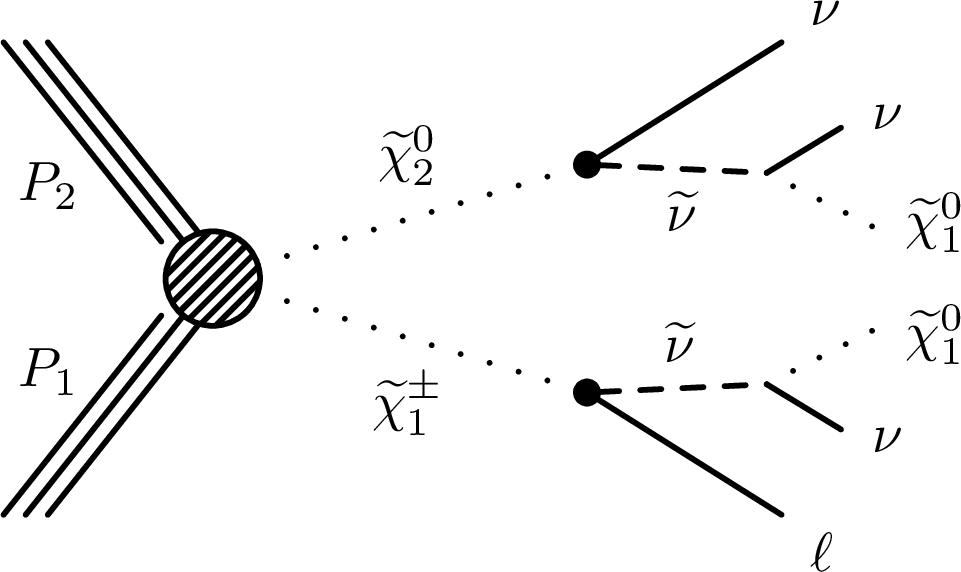
png pdf |
Figure 1-b:
Production of ˜χ±1˜χ02 with subsequent decays through sleptons (left) and sneutrinos (right). |

png pdf |
Figure 2:
Production of ˜χ±1˜χ02 with subsequent decay of ˜χ±1 through a W boson and ˜χ02 through a Z (left) or Higgs (right) boson. |
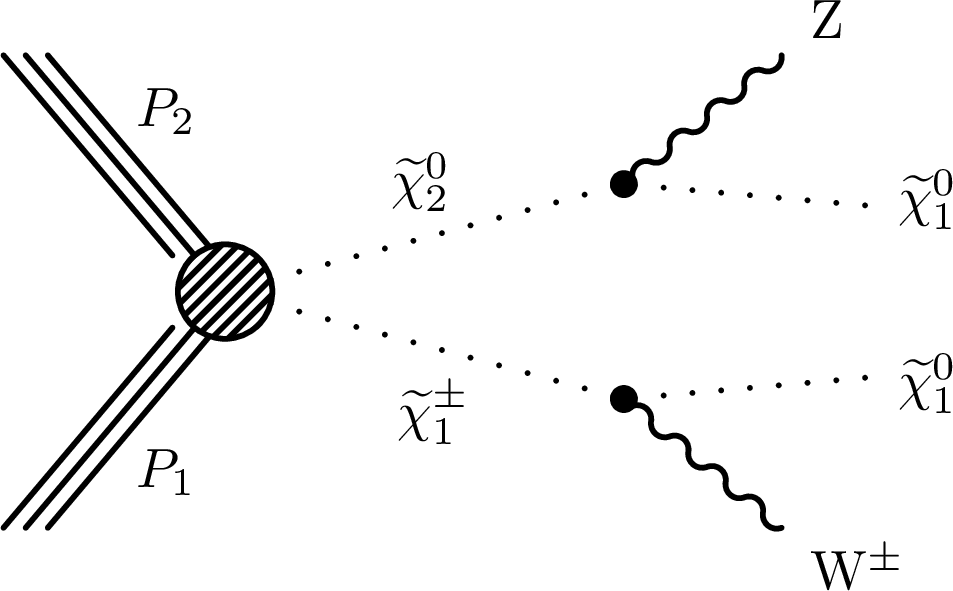
png pdf |
Figure 2-a:
Production of ˜χ±1˜χ02 with subsequent decay of ˜χ±1 through a W boson and ˜χ02 through a Z (left) or Higgs (right) boson. |
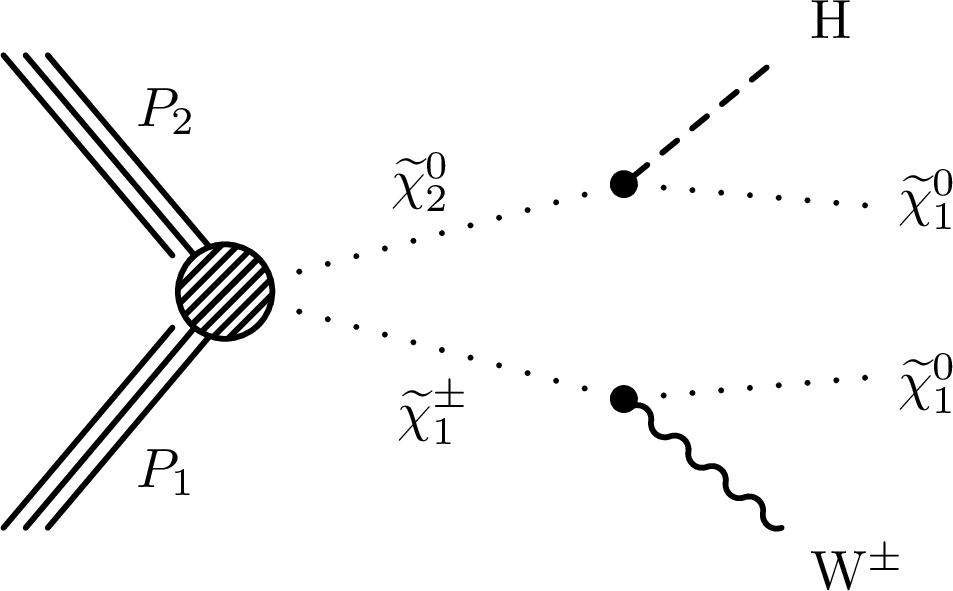
png pdf |
Figure 2-b:
Production of ˜χ±1˜χ02 with subsequent decay of ˜χ±1 through a W boson and ˜χ02 through a Z (left) or Higgs (right) boson. |

png pdf |
Figure 3:
Effective neutralino pair production with decays mediated by Z or Higgs bosons. |

png pdf |
Figure 3-a:
Effective neutralino pair production with decays mediated by Z or Higgs bosons. |
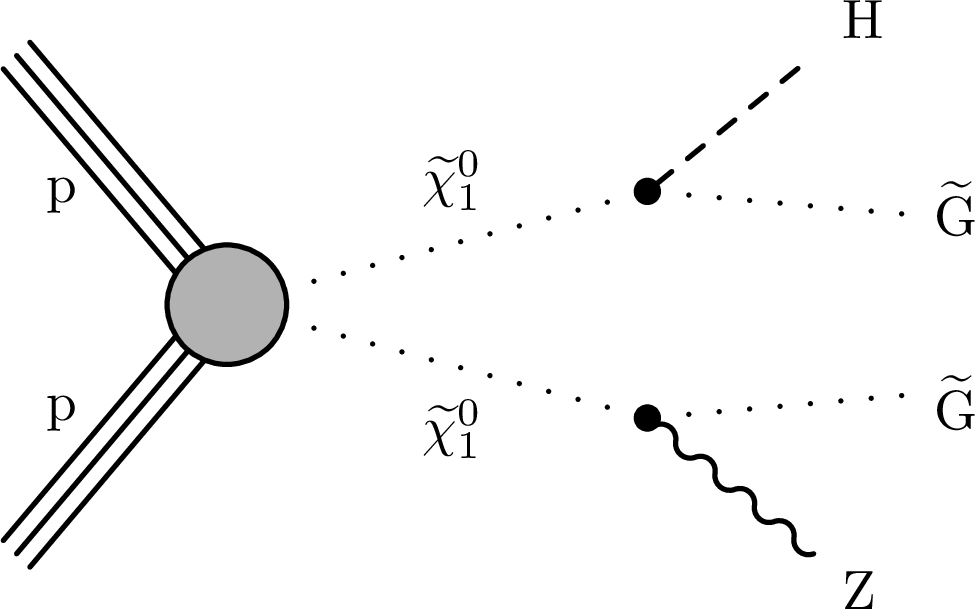
png pdf |
Figure 3-b:
Effective neutralino pair production with decays mediated by Z or Higgs bosons. |
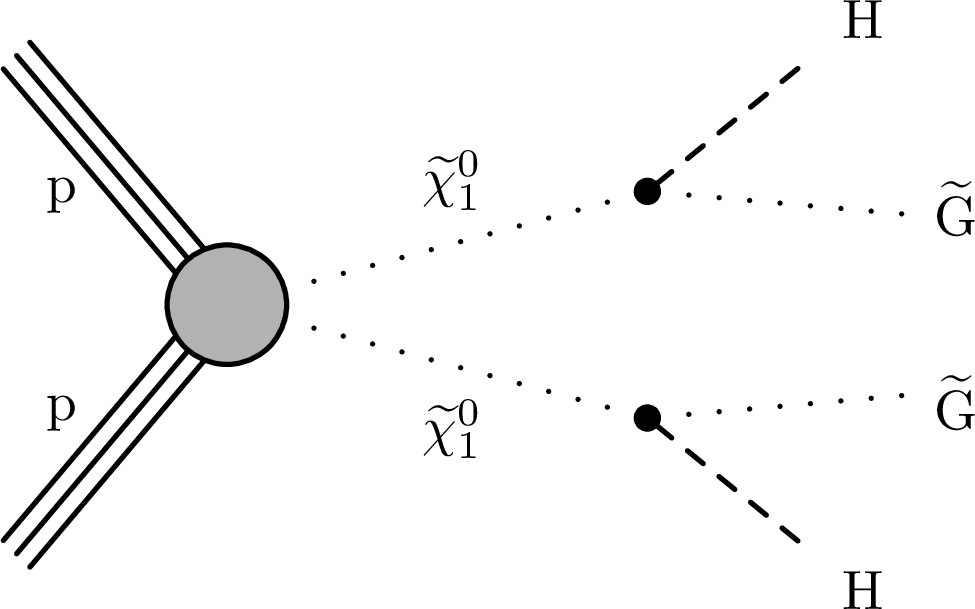
png pdf |
Figure 3-c:
Effective neutralino pair production with decays mediated by Z or Higgs bosons. |
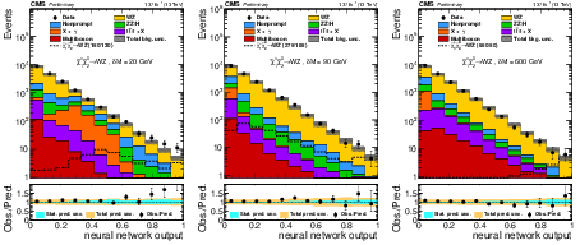
png pdf |
Figure 4:
Observed and expected yields as a function of the output of the neural network used to search for ˜χ01˜χ02 production with WZ mediated decays, evaluated at δM= 20 GeV (left), δM= 90 GeV (center), and δM= 600 GeV (right). |
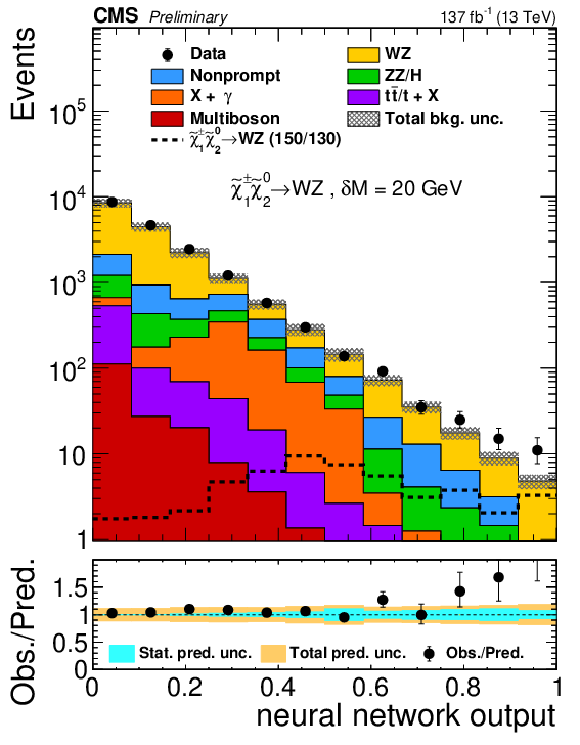
png pdf |
Figure 4-a:
Observed and expected yields as a function of the output of the neural network used to search for ˜χ01˜χ02 production with WZ mediated decays, evaluated at δM= 20 GeV (left), δM= 90 GeV (center), and δM= 600 GeV (right). |
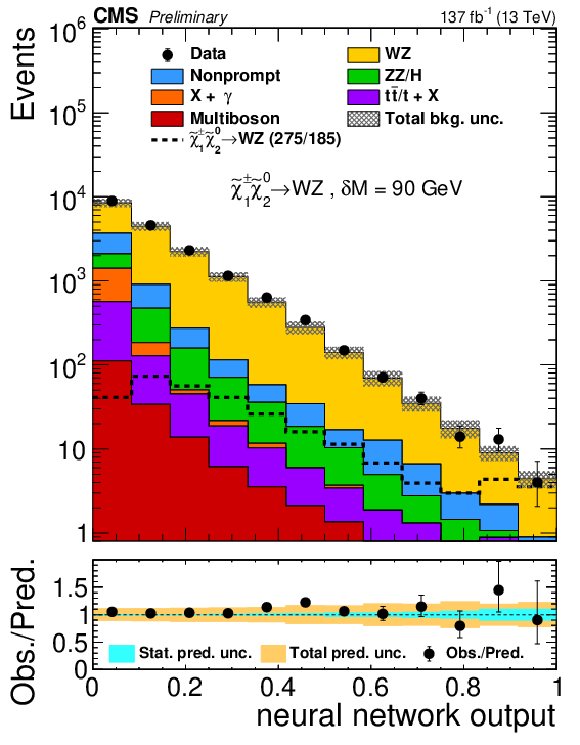
png pdf |
Figure 4-b:
Observed and expected yields as a function of the output of the neural network used to search for ˜χ01˜χ02 production with WZ mediated decays, evaluated at δM= 20 GeV (left), δM= 90 GeV (center), and δM= 600 GeV (right). |
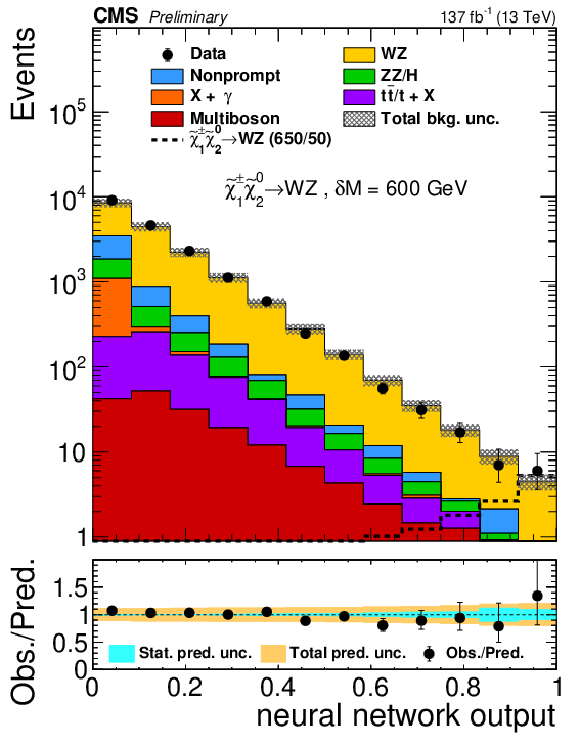
png pdf |
Figure 4-c:
Observed and expected yields as a function of the output of the neural network used to search for ˜χ01˜χ02 production with WZ mediated decays, evaluated at δM= 20 GeV (left), δM= 90 GeV (center), and δM= 600 GeV (right). |
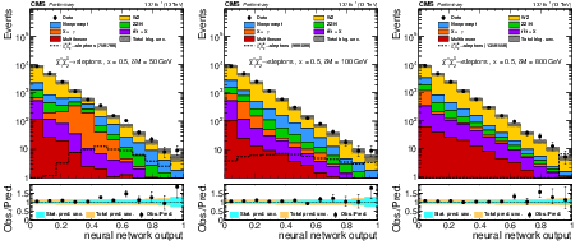
png pdf |
Figure 5:
Observed and expected yields as a function of the output of the neural network used to search for ˜χ01˜χ02 production with slepton mediated decays at x=0.5, evaluated at δM= 50 GeV (left), δM= 100 GeV (center), and δM= 800 GeV (right). |
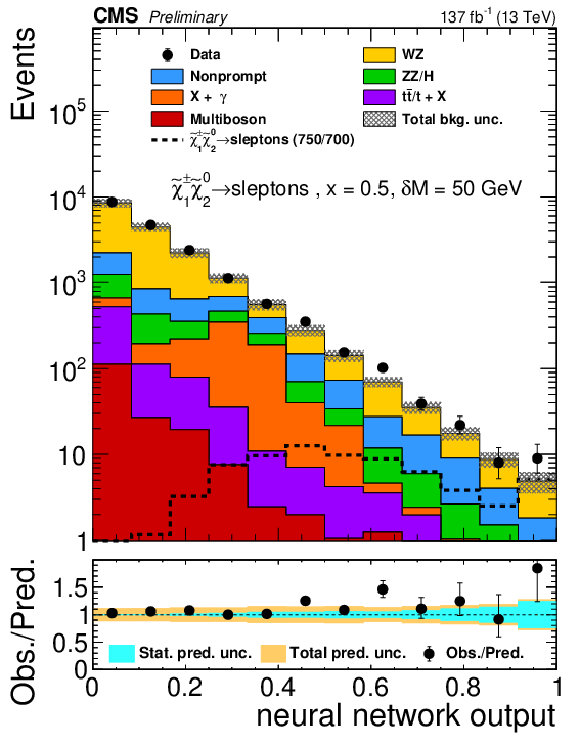
png pdf |
Figure 5-a:
Observed and expected yields as a function of the output of the neural network used to search for ˜χ01˜χ02 production with slepton mediated decays at x=0.5, evaluated at δM= 50 GeV (left), δM= 100 GeV (center), and δM= 800 GeV (right). |
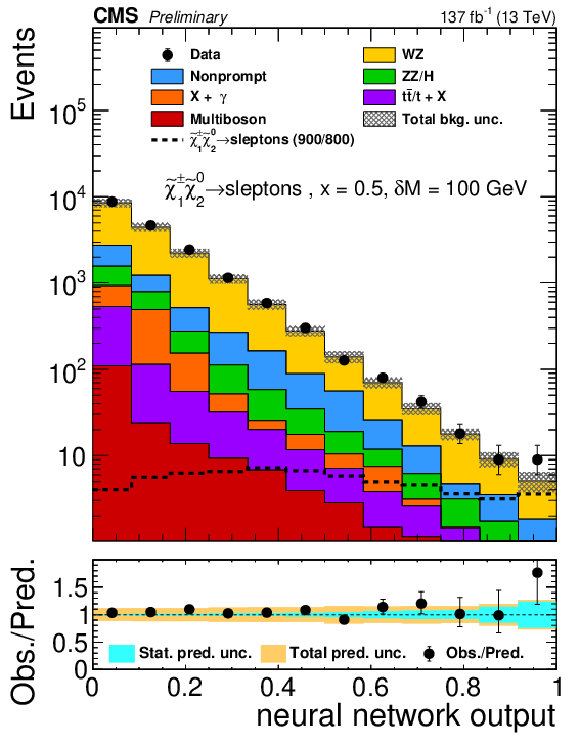
png pdf |
Figure 5-b:
Observed and expected yields as a function of the output of the neural network used to search for ˜χ01˜χ02 production with slepton mediated decays at x=0.5, evaluated at δM= 50 GeV (left), δM= 100 GeV (center), and δM= 800 GeV (right). |
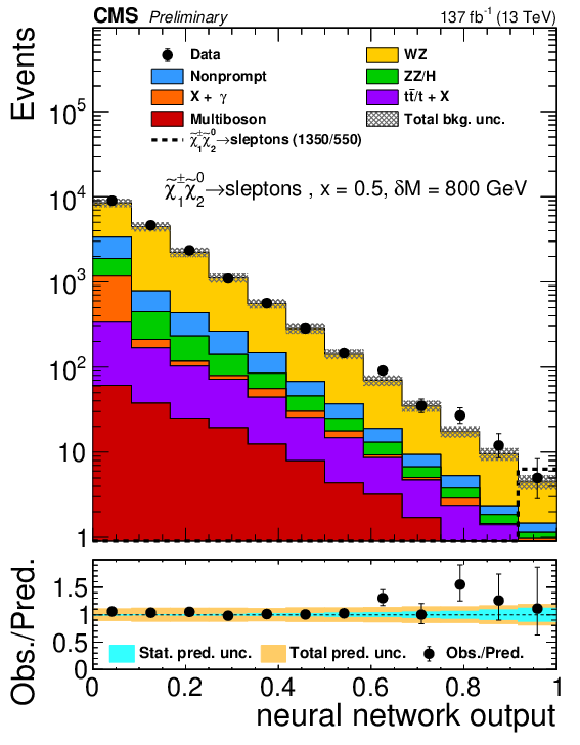
png pdf |
Figure 5-c:
Observed and expected yields as a function of the output of the neural network used to search for ˜χ01˜χ02 production with slepton mediated decays at x=0.5, evaluated at δM= 50 GeV (left), δM= 100 GeV (center), and δM= 800 GeV (right). |
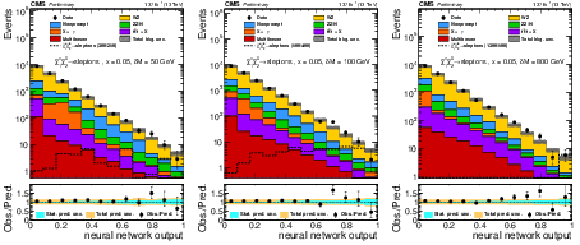
png pdf |
Figure 6:
Observed and expected yields as a function of the output of the neural network used to search for ˜χ01˜χ02 production with slepton mediated decays at x=0.05, evaluated at δM= 50 GeV (left), δM= 100 GeV (center), and δM= 800 GeV (right). |
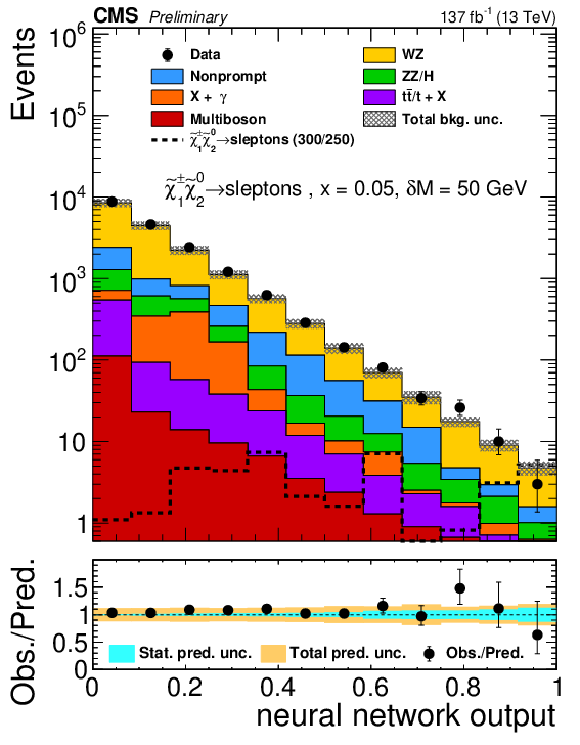
png pdf |
Figure 6-a:
Observed and expected yields as a function of the output of the neural network used to search for ˜χ01˜χ02 production with slepton mediated decays at x=0.05, evaluated at δM= 50 GeV (left), δM= 100 GeV (center), and δM= 800 GeV (right). |
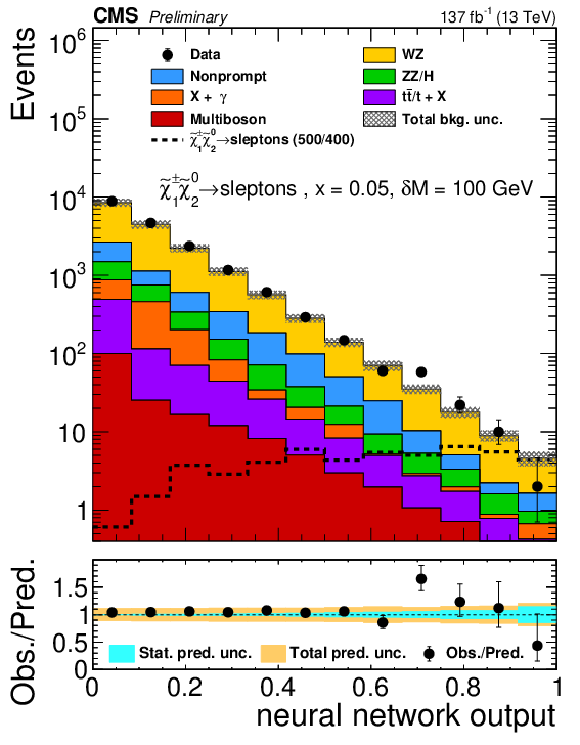
png pdf |
Figure 6-b:
Observed and expected yields as a function of the output of the neural network used to search for ˜χ01˜χ02 production with slepton mediated decays at x=0.05, evaluated at δM= 50 GeV (left), δM= 100 GeV (center), and δM= 800 GeV (right). |
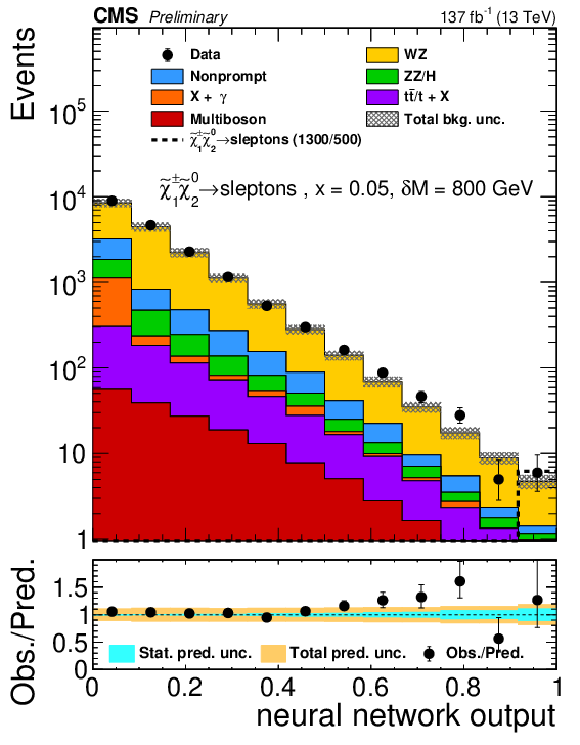
png pdf |
Figure 6-c:
Observed and expected yields as a function of the output of the neural network used to search for ˜χ01˜χ02 production with slepton mediated decays at x=0.05, evaluated at δM= 50 GeV (left), δM= 100 GeV (center), and δM= 800 GeV (right). |
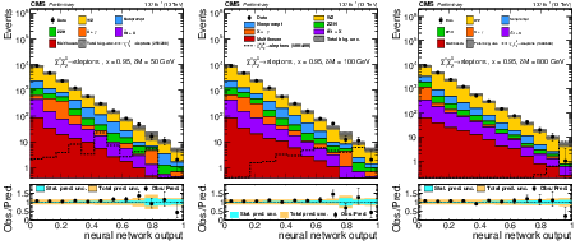
png pdf |
Figure 7:
Observed and expected yields as a function of the output of the neural network used to search for ˜χ01˜χ02 production with slepton mediated decays at x=0.95, evaluated at δM= 50 GeV (left), δM= 100 GeV (center), and δM= 800 GeV (right). |
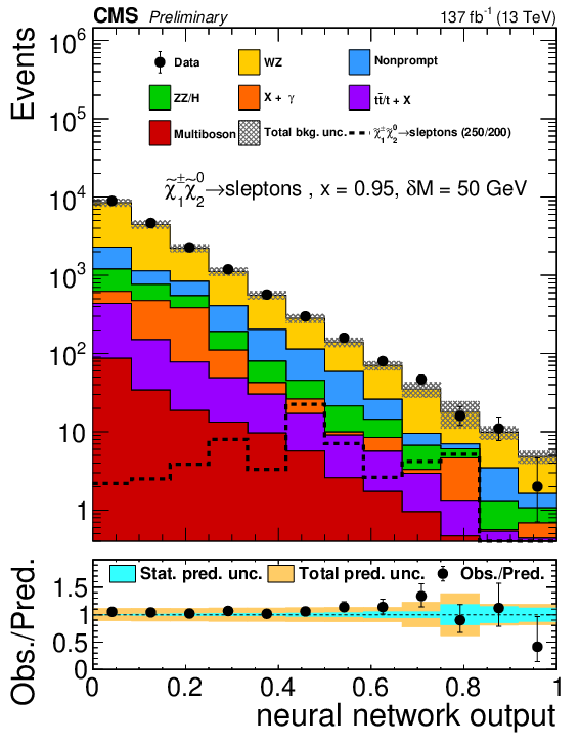
png pdf |
Figure 7-a:
Observed and expected yields as a function of the output of the neural network used to search for ˜χ01˜χ02 production with slepton mediated decays at x=0.95, evaluated at δM= 50 GeV (left), δM= 100 GeV (center), and δM= 800 GeV (right). |
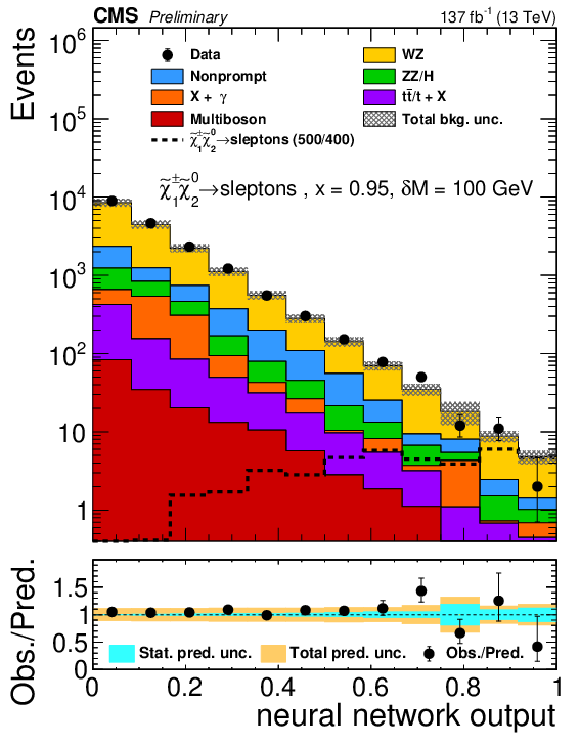
png pdf |
Figure 7-b:
Observed and expected yields as a function of the output of the neural network used to search for ˜χ01˜χ02 production with slepton mediated decays at x=0.95, evaluated at δM= 50 GeV (left), δM= 100 GeV (center), and δM= 800 GeV (right). |
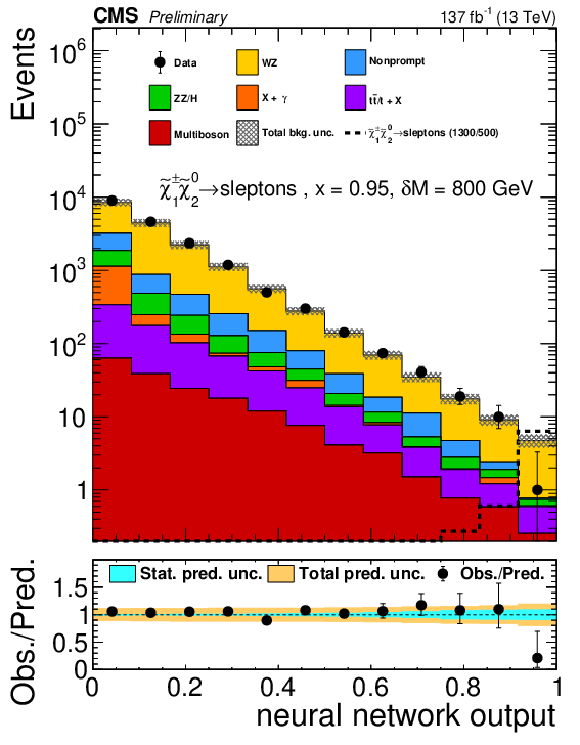
png pdf |
Figure 7-c:
Observed and expected yields as a function of the output of the neural network used to search for ˜χ01˜χ02 production with slepton mediated decays at x=0.95, evaluated at δM= 50 GeV (left), δM= 100 GeV (center), and δM= 800 GeV (right). |
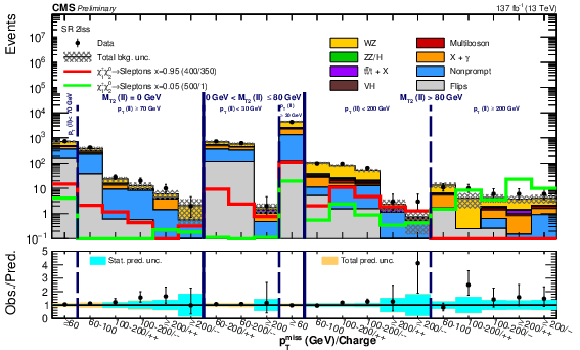
png pdf |
Figure 8:
Observed and expected yields across the search regions in events with two same-sign light leptons (2lSS). Signal models corresponding to ˜χ01˜χ02 production with slepton mediated decays in the flavor democratic hypothesis for a compressed δM= 50 GeV (red line) and uncompressed δM= 500 GeV (green line) scenarios are shown superimposed. |

png pdf |
Figure 9:
Observed and expected yields across the search regions in events with three light leptons at least two of which form an OSSF pair (3lA). Signal models corresponding to ˜χ01˜χ02 production with slepton mediated decays in the flavor democratic hypothesis for a compressed δM= 50 GeV (black line) and uncompressed δM= 900 GeV (blue line) scenarios as well, and for WZ mediated decay in an uncompressed δM= 500 GeV scenario (green line) are shown superimposed. Bins labeled as "Masked'' are not considered in the interpretation of the results because of overlap with the WZ control region. |
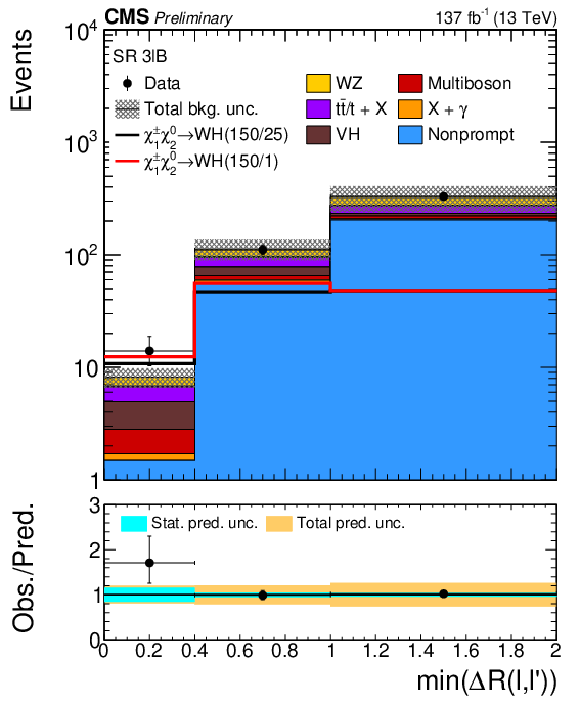
png pdf |
Figure 10:
Observed and expected yields across the search regions in events with three light leptons, none of which form an OSSF pair (3lB). Signal models corresponding to ˜χ01˜χ02 production with WH mediated decay for scenarios corresponding to a Higgs mass like mass splitting δM= 125 GeV (black line) and a slightly less compressed δM= 500 GeV (red line) scenarios are shown superimposed. |
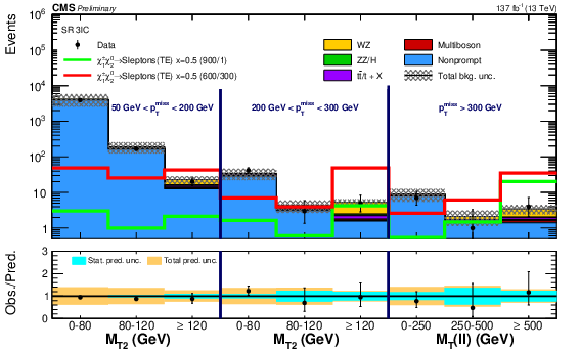
png pdf |
Figure 11:
Observed and expected yields across the search regions in events with a μ+μ− or e+e− pair and an additional τh (3lC). Signal models corresponding to ˜χ01˜χ02 production with slepton mediated decays in the tau enhanced hypothesis for a compressed δM= 300 GeV (red line) and uncompressed δM= 900 GeV (green line) scenarios are shown superimposed. |
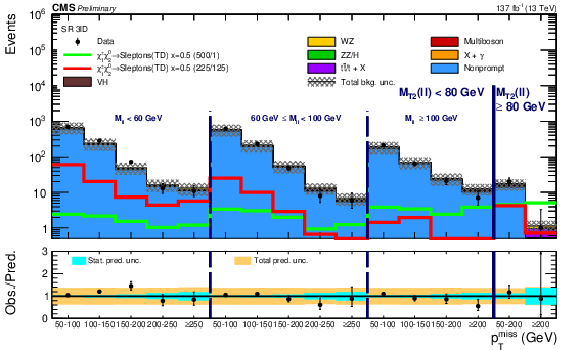
png pdf |
Figure 12:
Observed and expected yields across the search regions in events with a e±μ∓ pair and a τh (3lD). Signal models corresponding to ˜χ01˜χ02 production with slepton mediated decays in the tau dominated hypothesis for a compressed δM= 100 GeV (red line) and uncompressed δM= 500 GeV (green line) scenarios are shown superimposed. |
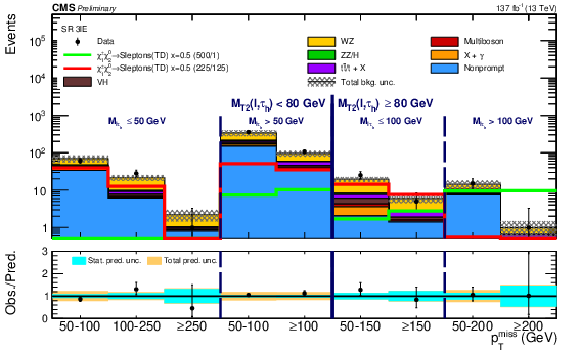
png pdf |
Figure 13:
Observed and expected yields across the search regions in events with a same-sign light lepton pair and a τh (3lE). Signal models corresponding to ˜χ01˜χ02 production with slepton mediated decays in the tau dominated hypothesis for a compressed δM= 100 GeV (red line) and uncompressed δM= 500 GeV (green line) scenarios are shown superimposed. |
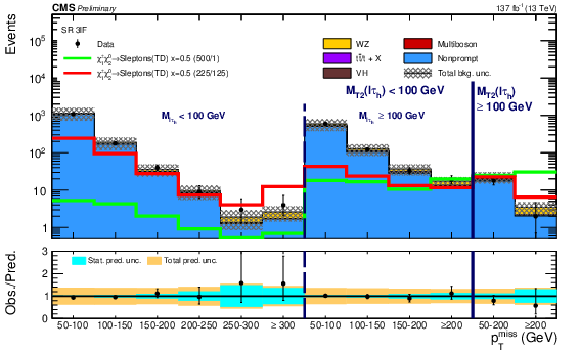
png pdf |
Figure 14:
Observed and expected yields across the search regions in events with two τh 's and one light lepton (3lF). Signal models corresponding to ˜χ01˜χ02 production with slepton mediated decays in the tau dominated hypothesis for a compressed δM= 100 GeV (red line) and uncompressed δM= 500 GeV (green line) scenarios are shown superimposed. |
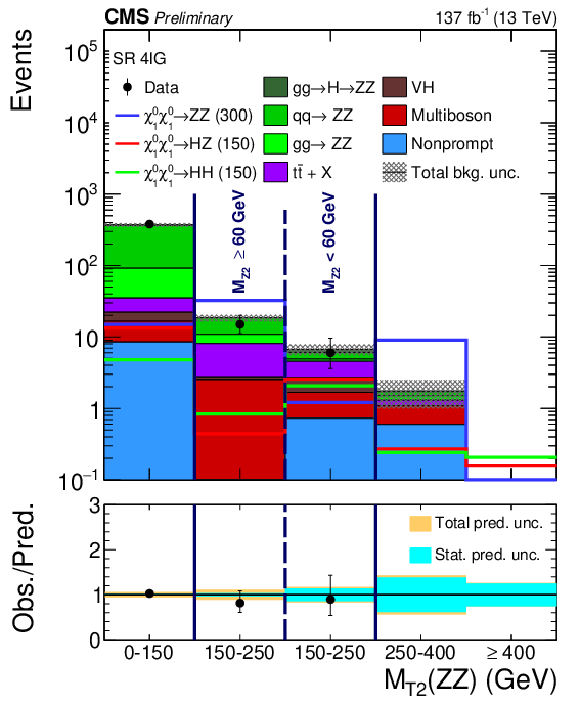
png pdf |
Figure 15:
Observed and expected yields across the search regions in events with four light leptons, including 2 separate OSSF pairs (4lG). Signal models corresponding to higgsino pair production with scenarios corresponding to decay to ZZ (blue line, Higgsino mass of 300 GeV), HZ (red line, Higgsino mass of 150 GeV), and HH (green line, Higgsino mass of 150 GeV) are shown superimposed. |
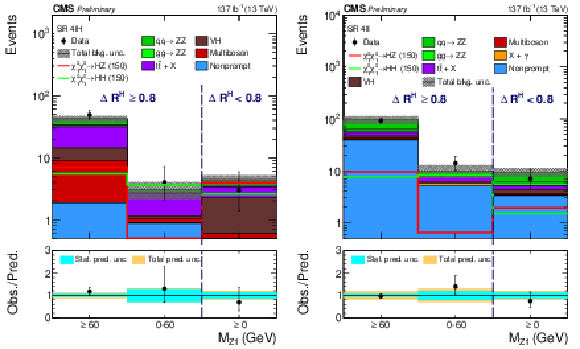
png pdf |
Figure 16:
Observed and expected yields across the search regions in events with four light leptons not forming two OSSF pairs (4lH, left), and in events with three light leptons and a τh (4lI, right). Signal models corresponding to higgsino pair production with scenarios corresponding to decay to HZ (red line, Higgsino mass of 150 GeV), and HH (green line, Higgsino mass of 150 GeV) are shown superimposed. |
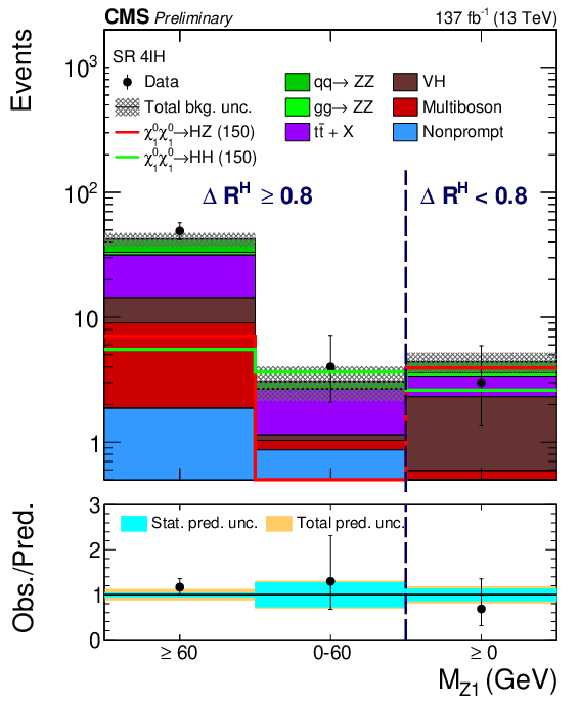
png pdf |
Figure 16-a:
Observed and expected yields across the search regions in events with four light leptons not forming two OSSF pairs (4lH, left), and in events with three light leptons and a τh (4lI, right). Signal models corresponding to higgsino pair production with scenarios corresponding to decay to HZ (red line, Higgsino mass of 150 GeV), and HH (green line, Higgsino mass of 150 GeV) are shown superimposed. |
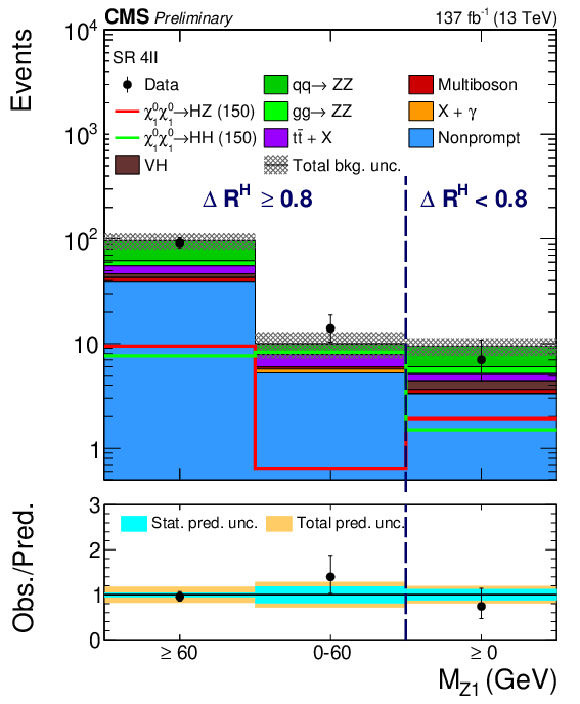
png pdf |
Figure 16-b:
Observed and expected yields across the search regions in events with four light leptons not forming two OSSF pairs (4lH, left), and in events with three light leptons and a τh (4lI, right). Signal models corresponding to higgsino pair production with scenarios corresponding to decay to HZ (red line, Higgsino mass of 150 GeV), and HH (green line, Higgsino mass of 150 GeV) are shown superimposed. |
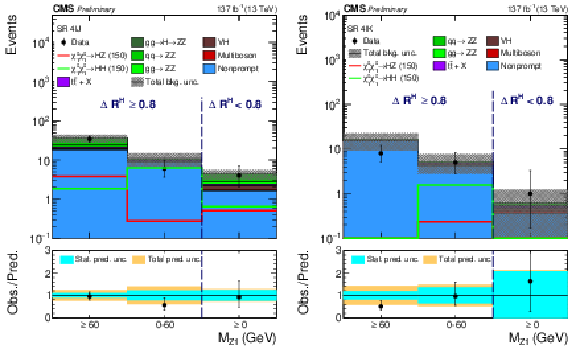
png pdf |
Figure 17:
Observed and expected yields across the search regions in events with two light leptons and two τh, forming two OSSF pairs (4lJ, left), and forming one or less OSSF pairs (4lK, right). Signal models corresponding to higgsino pair production with scenarios corresponding to decay to HZ (red line, Higgsino mass of 150 GeV), and HH (green line, Higgsino mass of 150 GeV) are shown superimposed. |
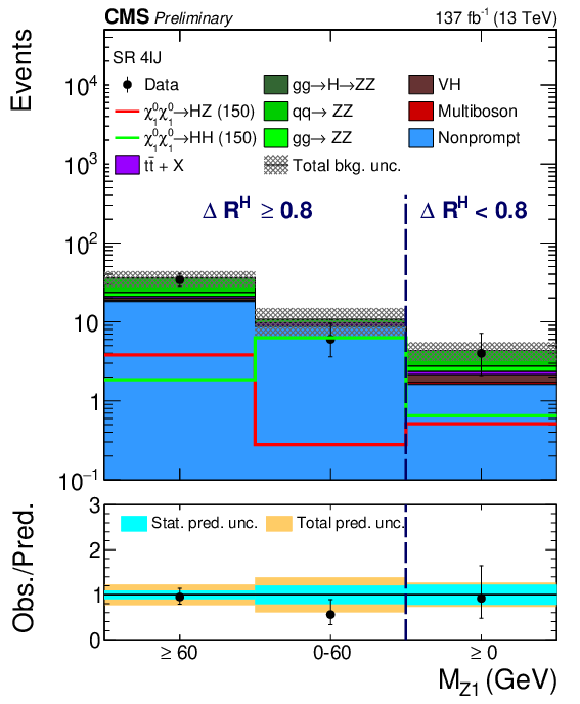
png pdf |
Figure 17-a:
Observed and expected yields across the search regions in events with two light leptons and two τh, forming two OSSF pairs (4lJ, left), and forming one or less OSSF pairs (4lK, right). Signal models corresponding to higgsino pair production with scenarios corresponding to decay to HZ (red line, Higgsino mass of 150 GeV), and HH (green line, Higgsino mass of 150 GeV) are shown superimposed. |
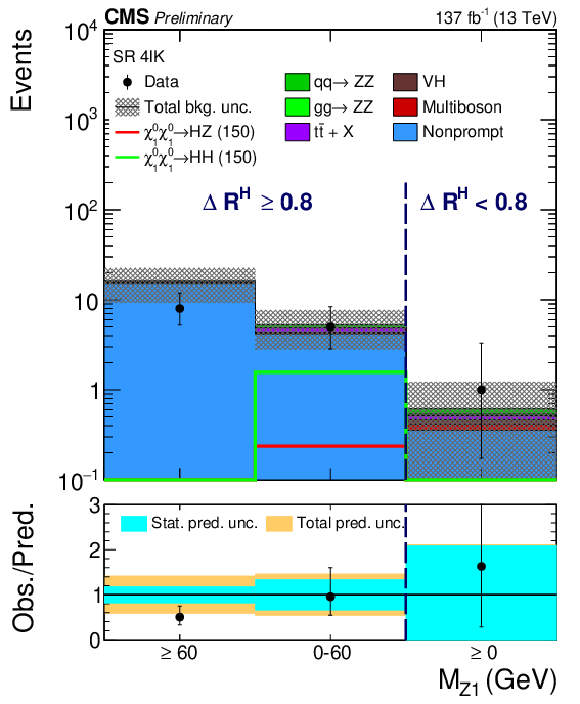
png pdf |
Figure 17-b:
Observed and expected yields across the search regions in events with two light leptons and two τh, forming two OSSF pairs (4lJ, left), and forming one or less OSSF pairs (4lK, right). Signal models corresponding to higgsino pair production with scenarios corresponding to decay to HZ (red line, Higgsino mass of 150 GeV), and HH (green line, Higgsino mass of 150 GeV) are shown superimposed. |

png pdf |
Figure 18:
Expected test statistic distribution for a background only fit compared to the observed test statistic value, drawn as black dots, for the search regions in each event category. The grey shaded area represents the probability density of the expected test statistic distribution, with 68% and 95% expected ranges respectively drawn in green and orange. |

png pdf |
Figure 19:
Expected test statistic distribution for a background only fit compared to the observed test statistic value, drawn as black dots, for the neural network targeting WZ mediated superpartner decays at each δM evaluation. The grey shaded area represents the probability density of the expected test statistic distribution, with 68% and 95% expected ranges respectively drawn in green and orange. |
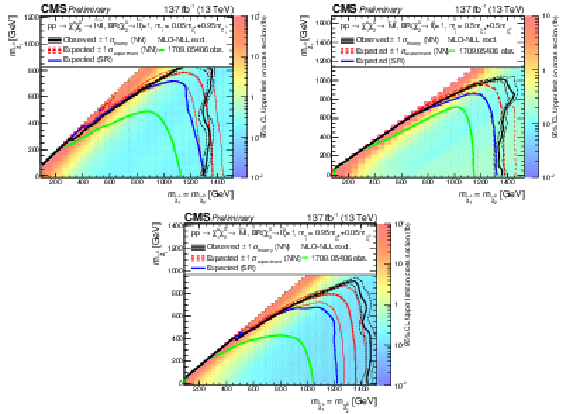
png pdf |
Figure 20:
Interpretation of the results for ˜χ±1˜χ02 production with flavor-democratic slepton mediated decays, and the parameter governing the mass splittings being x= 0.05 (upper left), x= 0.5 (upper right) and x= 0.95 (bottom). The shading in the m˜χ01 versus m˜χ02 plane indicates the 95% CL upper limit on the ˜χ±1˜χ02 production cross section. The contours delineate the mass regions excluded at 95% CL when assuming cross section computed at NLO plus NLL. The observed, observed ±1σtheory (±1 standard deviation of the theoretical cross sections), median expected, and expected ±1σexperiment bounds obtained with the neural network strategy are shown in black and red. The median expected bound obtained with the search region strategy is shown in blue. The observed limits obtained in the CMS analysis using 35.9 fb−1 of data [20] are shown in green. |
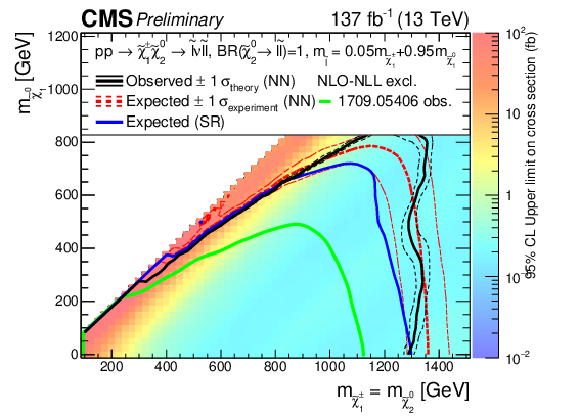
png pdf |
Figure 20-a:
Interpretation of the results for ˜χ±1˜χ02 production with flavor-democratic slepton mediated decays, and the parameter governing the mass splittings being x= 0.05 (upper left), x= 0.5 (upper right) and x= 0.95 (bottom). The shading in the m˜χ01 versus m˜χ02 plane indicates the 95% CL upper limit on the ˜χ±1˜χ02 production cross section. The contours delineate the mass regions excluded at 95% CL when assuming cross section computed at NLO plus NLL. The observed, observed ±1σtheory (±1 standard deviation of the theoretical cross sections), median expected, and expected ±1σexperiment bounds obtained with the neural network strategy are shown in black and red. The median expected bound obtained with the search region strategy is shown in blue. The observed limits obtained in the CMS analysis using 35.9 fb−1 of data [20] are shown in green. |
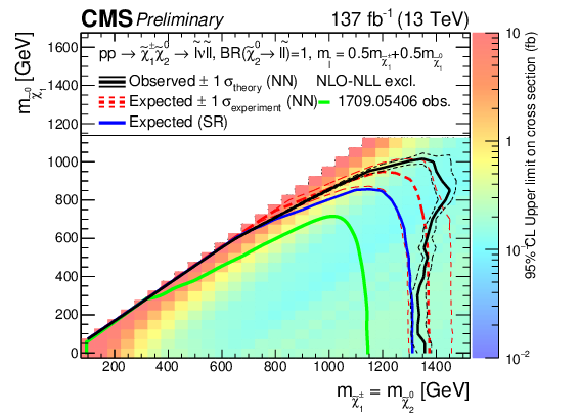
png pdf |
Figure 20-b:
Interpretation of the results for ˜χ±1˜χ02 production with flavor-democratic slepton mediated decays, and the parameter governing the mass splittings being x= 0.05 (upper left), x= 0.5 (upper right) and x= 0.95 (bottom). The shading in the m˜χ01 versus m˜χ02 plane indicates the 95% CL upper limit on the ˜χ±1˜χ02 production cross section. The contours delineate the mass regions excluded at 95% CL when assuming cross section computed at NLO plus NLL. The observed, observed ±1σtheory (±1 standard deviation of the theoretical cross sections), median expected, and expected ±1σexperiment bounds obtained with the neural network strategy are shown in black and red. The median expected bound obtained with the search region strategy is shown in blue. The observed limits obtained in the CMS analysis using 35.9 fb−1 of data [20] are shown in green. |
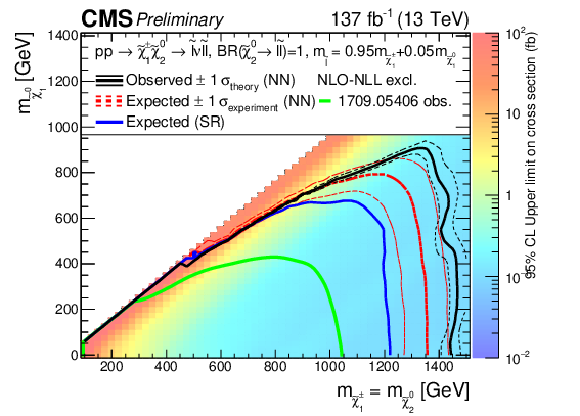
png pdf |
Figure 20-c:
Interpretation of the results for ˜χ±1˜χ02 production with flavor-democratic slepton mediated decays, and the parameter governing the mass splittings being x= 0.05 (upper left), x= 0.5 (upper right) and x= 0.95 (bottom). The shading in the m˜χ01 versus m˜χ02 plane indicates the 95% CL upper limit on the ˜χ±1˜χ02 production cross section. The contours delineate the mass regions excluded at 95% CL when assuming cross section computed at NLO plus NLL. The observed, observed ±1σtheory (±1 standard deviation of the theoretical cross sections), median expected, and expected ±1σexperiment bounds obtained with the neural network strategy are shown in black and red. The median expected bound obtained with the search region strategy is shown in blue. The observed limits obtained in the CMS analysis using 35.9 fb−1 of data [20] are shown in green. |

png pdf |
Figure 21:
Interpretation of the results for ˜χ±1˜χ02 production with τ-enriched slepton mediated decays, and the parameter governing the mass splittings being x= 0.05 (upper left), x= 0.5 (upper right) and x= 0.95 (bottom). The contents of the plot are as described in the caption of Fig. yyyyy. |
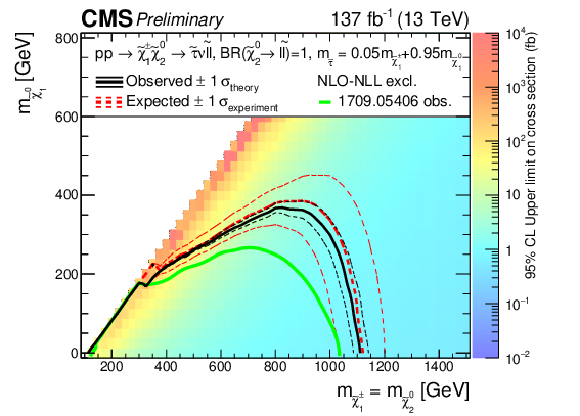
png pdf |
Figure 21-a:
Interpretation of the results for ˜χ±1˜χ02 production with τ-enriched slepton mediated decays, and the parameter governing the mass splittings being x= 0.05 (upper left), x= 0.5 (upper right) and x= 0.95 (bottom). The contents of the plot are as described in the caption of Fig. yyyyy. |
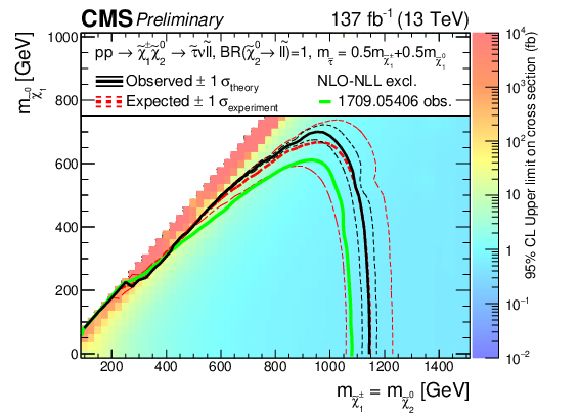
png pdf |
Figure 21-b:
Interpretation of the results for ˜χ±1˜χ02 production with τ-enriched slepton mediated decays, and the parameter governing the mass splittings being x= 0.05 (upper left), x= 0.5 (upper right) and x= 0.95 (bottom). The contents of the plot are as described in the caption of Fig. yyyyy. |
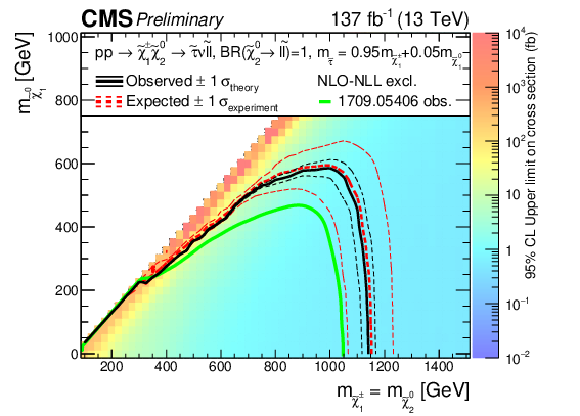
png pdf |
Figure 21-c:
Interpretation of the results for ˜χ±1˜χ02 production with τ-enriched slepton mediated decays, and the parameter governing the mass splittings being x= 0.05 (upper left), x= 0.5 (upper right) and x= 0.95 (bottom). The contents of the plot are as described in the caption of Fig. yyyyy. |
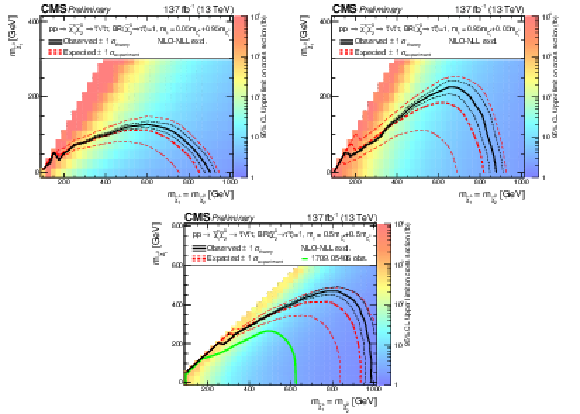
png pdf |
Figure 22:
Interpretation of the results for ˜χ±1˜χ02 production with τ-dominated slepton mediated decays, and the parameter governing the mass splittings being x= 0.05 (upper left), x= 0.5 (upper right) and x= 0.95 (bottom). The contents of the plot are as described in the caption of Fig. yyyyy. |
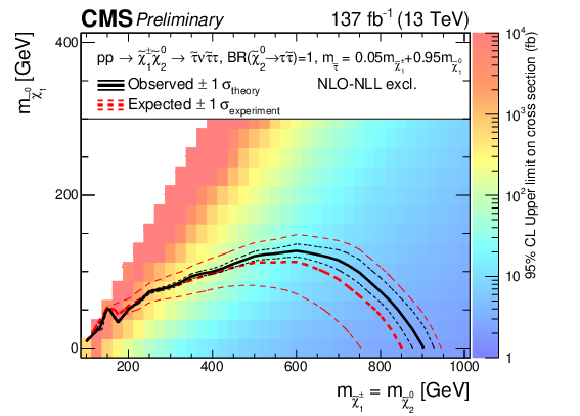
png pdf |
Figure 22-a:
Interpretation of the results for ˜χ±1˜χ02 production with τ-dominated slepton mediated decays, and the parameter governing the mass splittings being x= 0.05 (upper left), x= 0.5 (upper right) and x= 0.95 (bottom). The contents of the plot are as described in the caption of Fig. yyyyy. |
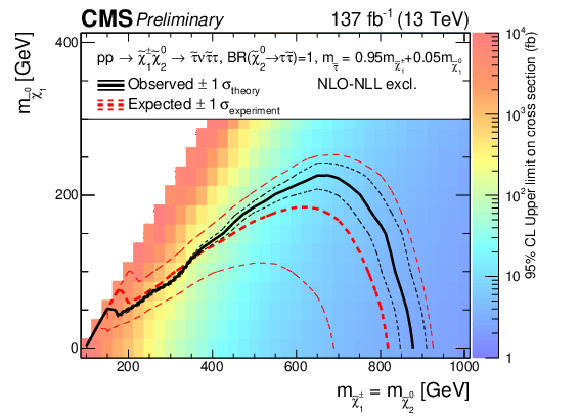
png pdf |
Figure 22-b:
Interpretation of the results for ˜χ±1˜χ02 production with τ-dominated slepton mediated decays, and the parameter governing the mass splittings being x= 0.05 (upper left), x= 0.5 (upper right) and x= 0.95 (bottom). The contents of the plot are as described in the caption of Fig. yyyyy. |
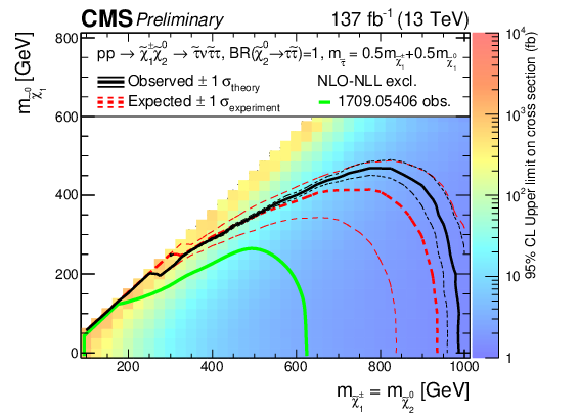
png pdf |
Figure 22-c:
Interpretation of the results for ˜χ±1˜χ02 production with τ-dominated slepton mediated decays, and the parameter governing the mass splittings being x= 0.05 (upper left), x= 0.5 (upper right) and x= 0.95 (bottom). The contents of the plot are as described in the caption of Fig. yyyyy. |
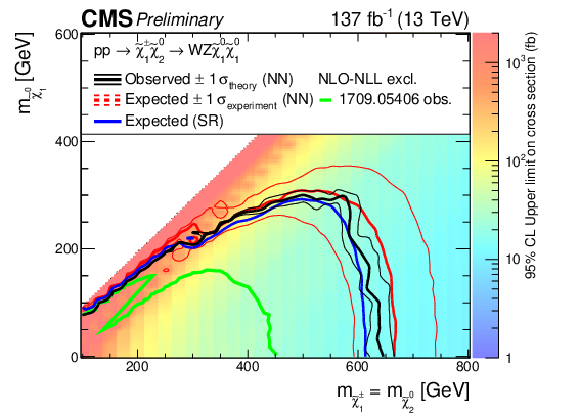
png pdf |
Figure 23:
Interpretation of the results for ˜χ±1˜χ02 production with WZ mediated decays. The contents of the plot are as described in the caption of Fig. yyyyy. |
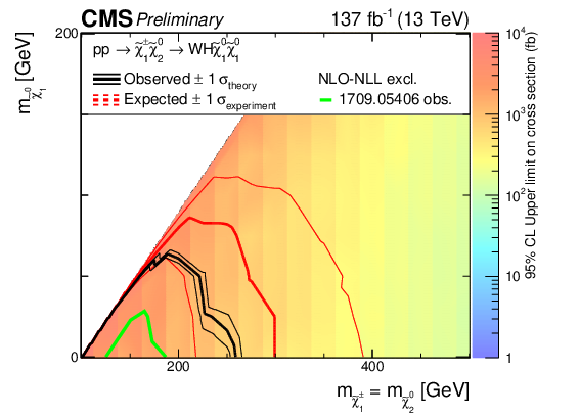
png pdf |
Figure 24:
Interpretation of the results for ˜χ±1˜χ02 production with WH mediated decays. The contents of the plot are as described in the caption of Fig. yyyyy. |
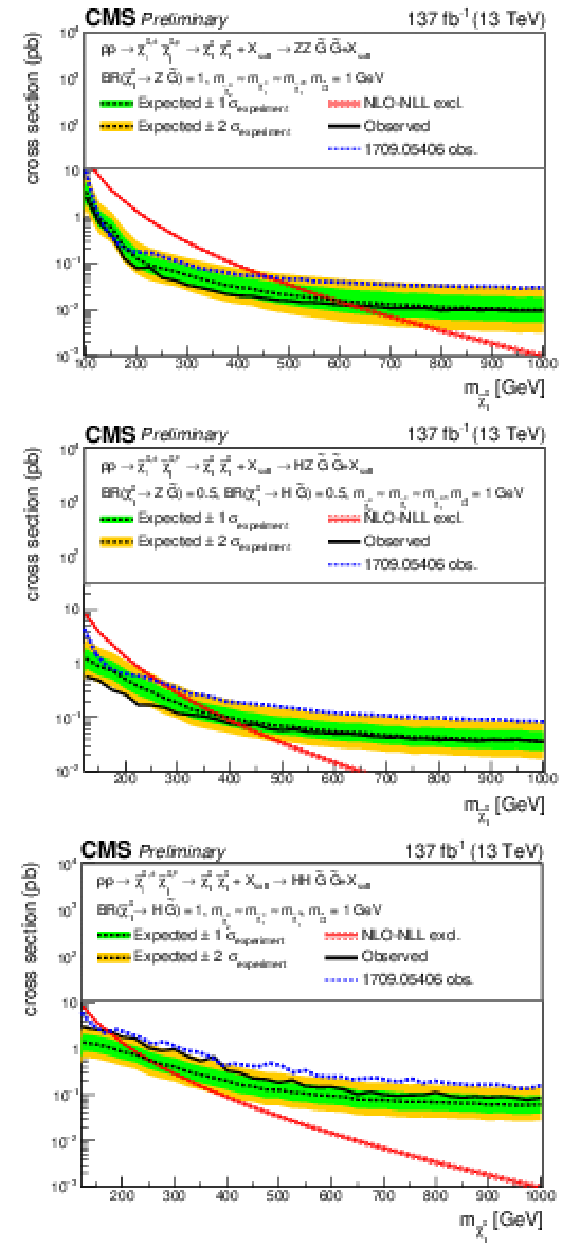
png pdf |
Figure 25:
Interpretation of the results for ˜χ01 pair production, with ZZ mediated decays (upper), HZ mediated decays (middle), and HH mediated decays (bottom). The median expected upper limits (black line) are shown along with the ±1σ (0.16 and 0.84 quantiles, green) and ±2σ (0.05 and 0.95 quantiles, yellow) bands. |
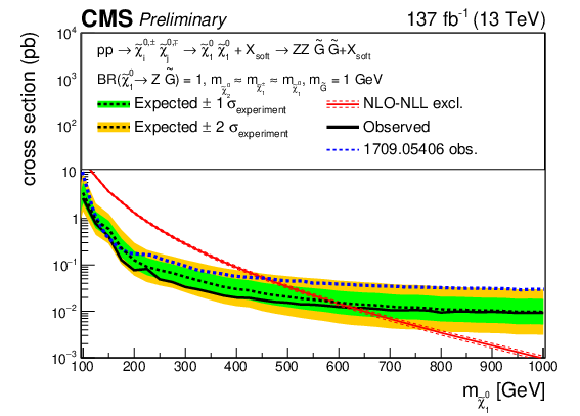
png pdf |
Figure 25-a:
Interpretation of the results for ˜χ01 pair production, with ZZ mediated decays (upper), HZ mediated decays (middle), and HH mediated decays (bottom). The median expected upper limits (black line) are shown along with the ±1σ (0.16 and 0.84 quantiles, green) and ±2σ (0.05 and 0.95 quantiles, yellow) bands. |
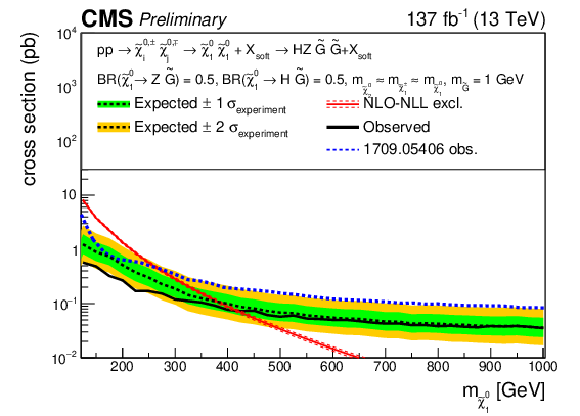
png pdf |
Figure 25-b:
Interpretation of the results for ˜χ01 pair production, with ZZ mediated decays (upper), HZ mediated decays (middle), and HH mediated decays (bottom). The median expected upper limits (black line) are shown along with the ±1σ (0.16 and 0.84 quantiles, green) and ±2σ (0.05 and 0.95 quantiles, yellow) bands. |
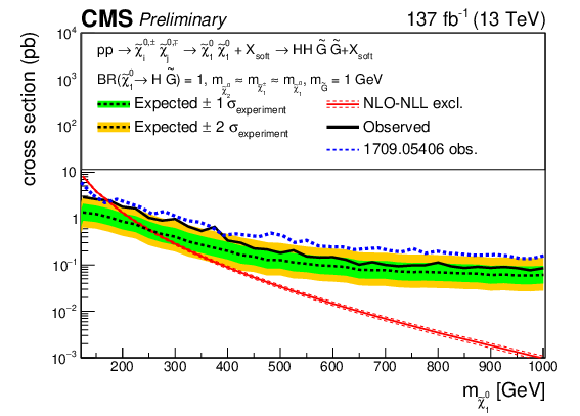
png pdf |
Figure 25-c:
Interpretation of the results for ˜χ01 pair production, with ZZ mediated decays (upper), HZ mediated decays (middle), and HH mediated decays (bottom). The median expected upper limits (black line) are shown along with the ±1σ (0.16 and 0.84 quantiles, green) and ±2σ (0.05 and 0.95 quantiles, yellow) bands. |
| Tables | |
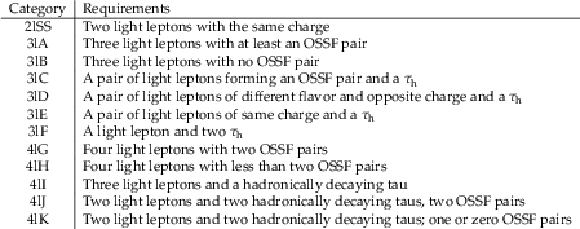
png pdf |
Table 1:
Brief description of the categories used to classify events in the search. |

png pdf |
Table 2:
Definition of the search regions used for events with two same-sign light leptons. The symbols (++) and (- -) represent requirements on the charge of the leptons. |

png pdf |
Table 3:
Definition of the search regions used for events with three light leptons at least two of which form an OSSF pair, excluding those with 75GeV<Mℓℓ< 105 GeV. |
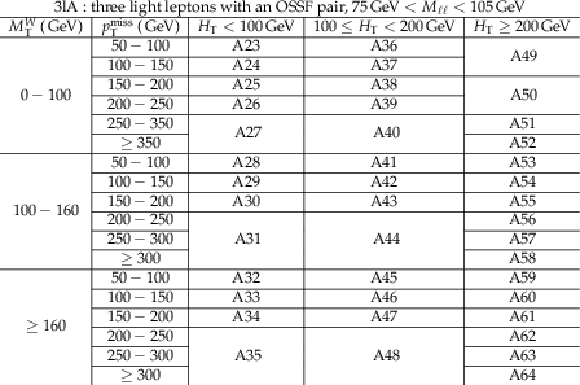
png pdf |
Table 4:
Definition of the search regions used for events with three light leptons at least two of which form an OSSF pair, and which satisfy 75GeV<Mℓℓ< 105 GeV. |

png pdf |
Table 5:
Definition of the search regions used for events with three light leptons, none of which form an OSSF pair. |

png pdf |
Table 6:
Definition of the search regions for events with a μ+μ− or e+e− pair and an additional τh. |

png pdf |
Table 7:
Definition of the search regions for events with a e±μ∓ pair and a τh. |

png pdf |
Table 8:
Definition of the search regions for events with a same-sign light lepton pair and a τh. |
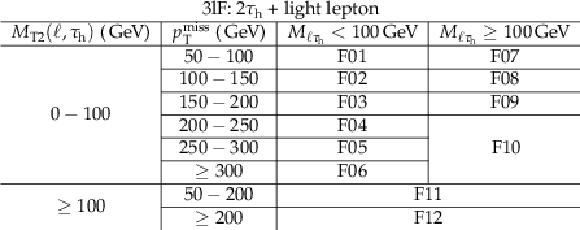
png pdf |
Table 9:
Definition of the search regions for events with 2 τh 's and one light lepton. |

png pdf |
Table 10:
Definition of the search regions for events with 4 light leptons, including 2 separate OSSF pairs |

png pdf |
Table 11:
Definition of the search regions for events with 4 leptons with one or more τh, or without two light lepton OSSF pairs. |
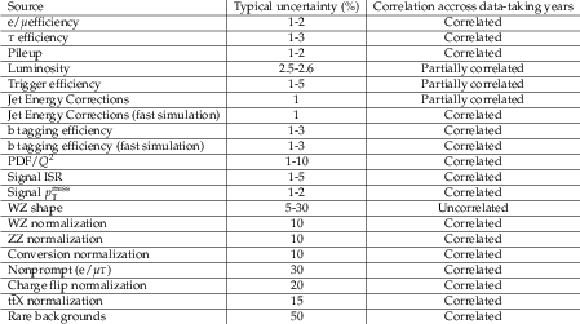
png pdf |
Table 12:
Systematic uncertainties sources affecting the analysis, with their typical impact on the event yields across the search regions, and the treatment of the correlations across data taking years. Some of the uncertainty sources are treated as uncorrelated across data taking years, while others are treated as correlated. Uncertainties are allowed to vary the normalization of processes across all bins, and in some cases both the normalization and shapes. Uncertainties in the jet energy corrections and b tagging efficiencies are considered separately for signal events which use CMS fast simulation as explained in Section xxxxx, and for the other simulated processes. |

png pdf |
Table 13:
Summary of the event categories used for the interpretation of the results in terms of different models, and references to the associated figure summarizing the expected and observed 95% CL upper limits. |
| Summary |
|
A search for new physics in events with two lepton of the same charge, or with three or more leptons with up to two hadronically decaying τ lepton, is presented. A dataset of proton-proton collision with √s= 13 TeV collected by the CMS detector at the LHC, corresponding to an integrated luminosity of 137 fb−1 is analyzed. Events are categorized according to the number of leptons, their charges and flavors. Events in each category are further binned using a plethora of kinematic quantities to maximize the sensitivity of the search to an expansive set of hypotheses of supersymmetric particle production via the electroweak interaction. In events with three light leptons, two of which have opposite-sign and same flavor (OSSF), parametric neural networks are used to markedly enhance the sensitivity of the search to several signal hypotheses. No significant deviation from the standard model expectation is observed in any of the event categories, and the null results are interpreted in terms of a number of simplified models of superpartner production. Models of chargino-neutralino pair production with the neutralino forming the lightest supersymmetric particle (LSP), as well as models of effective neutralino pair production with a nearly massless gravitino as the LSP are considered. Exact signal topologies depend on the masses of the leptonic superpartners and the gauge eigenstates mixing into the charginos and neutralinos. If left-handed sleptons lighter than the chargino exist, the chargino-neutralino pair might undergo slepton mediated decays resulting in final states with three leptons. The results of the analysis lead to upper limits of the chargino masses up to 1450 GeV when using a parametric neural network. Searches in events with three light leptons including an OSSF pair provide sensitivity to these models, while events with two same-sign leptons further enhance the sensitivity in experimentally challenging scenarios with small mass differences between charginos and the LSP. If sleptons would be right-handed, the chargino or both the chargino and the neutralino might decay almost exclusively to τ leptons. In the former scenario chargino masses up to 1150 GeV are excluded, while masses up to 970 GeV are excluded in the latter. Charginos and neutralinos would undergo direct decay to the LSP via the emission of W, Z or Higgs bosons if sleptons are sufficiently heavy. For decays of the chargino-neutralino pair via a W and a Z boson, chargino masses up to 650 GeV are excluded through the usage of a parametric neural network. If the neutralino's decay proceeds via the emission of a Higgs boson, chargino masses up to 300 GeV can be excluded. Models of effective neutralino pair production with an effectively massless gravitino LSP with subsequent decays via Z and Higgs bosons lead to the exclusion of neutralino masses up to 600 GeV. |
| References | ||||
| 1 | P. Ramond | Dual theory for free fermions | PRD 3 (1971) 2415 | |
| 2 | J. Wess and B. Zumino | A lagrangian model invariant under supergauge transformations | Physics Letters B 49 (1974) 52 | |
| 3 | J. Wess and B. Zumino | Supergauge transformations in four dimensions | Nuclear Physics B 70 (1974) 39 | |
| 4 | P. Fayet | Supergauge invariant extension of the higgs mechanism and a model for the electron and its neutrino | Nuclear Physics B 90 (1975) 104 | |
| 5 | H. Nilles | Supersymmetry, supergravity and particle physics | Physics Reports 110 (1984) 1 | |
| 6 | S. P. Martin | volume 21, p. 1 2010 | hep-ph/9709356 | |
| 7 | CMS Collaboration | Search for supersymmetry in proton-proton collisions at 13 TeV in final states with jets and missing transverse momentum | JHEP 10 (2019) 244 | CMS-SUS-19-006 1908.04722 |
| 8 | CMS Collaboration | Searches for physics beyond the standard model with the MT2 variable in hadronic final states with and without disappearing tracks in proton-proton collisions at √s= 13 TeV | EPJC 80 (2020) 3 | CMS-SUS-19-005 1909.03460 |
| 9 | CMS Collaboration | Search for supersymmetry in pp collisions at √s= 13 TeV with 137 fb−1 in final states with a single lepton using the sum of masses of large-radius jets | PRD 101 (2020) 052010 | CMS-SUS-19-007 1911.07558 |
| 10 | CMS Collaboration | Search for physics beyond the standard model in events with jets and two same-sign or at least three charged leptons in proton-proton collisions at √s= 13 TeV | EPJC 80 (2020) 752 | CMS-SUS-19-008 2001.10086 |
| 11 | CMS Collaboration | Search for direct top squark pair production in events with one lepton, jets, and missing transverse momentum at 13 TeV with the CMS experiment | JHEP 05 (2020) 032 | CMS-SUS-19-009 1912.08887 |
| 12 | ATLAS Collaboration | Search for top squarks in events with a Higgs or Z boson using 139 fb−1 of pp collision data at √s= 13 TeV with the ATLAS detector | EPJC 80 (2020) 1080 | 2006.05880 |
| 13 | ATLAS Collaboration | Search for a scalar partner of the top quark in the all-hadronic tˉt plus missing transverse momentum final state at √s= 13 TeV with the ATLAS detector | EPJC 80 (2020) 737 | 2004.14060 |
| 14 | ATLAS Collaboration | Search for long-lived, massive particles in events with a displaced vertex and a muon with large impact parameter in pp collisions at √s= 13 TeV with the ATLAS detector | PRD 102 (2020) 032006 | 2003.11956 |
| 15 | ATLAS Collaboration | Search for squarks and gluinos in final states with same-sign leptons and jets using 139 fb−1 of data collected with the ATLAS detector | JHEP 06 (2020) 046 | 1909.08457 |
| 16 | ATLAS Collaboration | Search for bottom-squark pair production with the ATLAS detector in final states containing Higgs bosons, b-jets and missing transverse momentum | JHEP 12 (2019) 060 | 1908.03122 |
| 17 | ATLAS Collaboration | Search for chargino-neutralino production with mass splittings near the electroweak scale in three-lepton final states in √s=13TeVpp collisions with the ATLAS detector | PRD 101 (2020) 072001 | 1912.08479 |
| 18 | ATLAS Collaboration | Search for electroweak production of supersymmetric particles in final states with two or three leptons at √s= 13 TeV with the ATLAS detector | EPJC 78 (2018) 995 | 1803.02762 |
| 19 | ATLAS Collaboration | Search for supersymmetry in events with four or more leptons in √s=13TeVpp collisions with ATLAS | PRD 98 (2018) 032009 | 1804.03602 |
| 20 | CMS Collaboration | Search for electroweak production of charginos and neutralinos in multilepton final states in proton-proton collisions at √s= 13 TeV | JHEP 03 (2018) 166 | CMS-SUS-16-039 1709.05406 |
| 21 | CMS Collaboration | Combined search for electroweak production of charginos and neutralinos in proton-proton collisions at √s= 13 TeV | JHEP 03 (2018) 160 | CMS-SUS-17-004 1801.03957 |
| 22 | P. Baldi et al. | Parameterized neural networks for high-energy physics | EPJC 76 (2016) 235 | 1601.07913 |
| 23 | CMS Collaboration | The CMS experiment at the CERN LHC | JINST 3 (2008) S08004 | CMS-00-001 |
| 24 | LHC New Physics Working Group Collaboration | Simplified Models for LHC New Physics Searches | JPG39 (2012) 105005 | 1105.2838 |
| 25 | CMS Collaboration | Interpretation of Searches for Supersymmetry with Simplified Models | PRD 88 (2013) 052017 | CMS-SUS-11-016 1301.2175 |
| 26 | LHC Higgs Cross Section Working Group | Handbook of LHC Higgs cross sections: 4. deciphering the nature of the Higgs sector | CERN (2016) | 1610.07922 |
| 27 | K. T. Matchev and S. D. Thomas | Higgs and Z boson signatures of supersymmetry | PRD 62 (2000) 077702 | hep-ph/9908482 |
| 28 | J. T. Ruderman and D. Shih | General Neutralino NLSPs at the Early LHC | JHEP 08 (2012) 159 | 1103.6083 |
| 29 | P. Meade, M. Reece, and D. Shih | Prompt Decays of General Neutralino NLSPs at the Tevatron | JHEP 05 (2010) 105 | 0911.4130 |
| 30 | W. Beenakker et al. | The Production of charginos / neutralinos and sleptons at hadron colliders | PRL 83 (1999) 3780 | hep-ph/9906298 |
| 31 | B. Fuks, M. Klasen, D. R. Lamprea, and M. Rothering | Gaugino production in proton-proton collisions at a center-of-mass energy of 8 TeV | JHEP 10 (2012) 081 | 1207.2159 |
| 32 | B. Fuks, M. Klasen, D. R. Lamprea, and M. Rothering | Precision predictions for electroweak superpartner production at hadron colliders with Resummino | EPJC 73 (2013) 2480 | 1304.0790 |
| 33 | CMS Collaboration | Particle-flow reconstruction and global event description with the CMS detector | JINST 12 (2017) P10003 | CMS-PRF-14-001 1706.04965 |
| 34 | M. Cacciari, G. P. Salam, and G. Soyez | The anti-kt jet clustering algorithm | JHEP 04 (2008) 063 | 0802.1189 |
| 35 | M. Cacciari and G. P. Salam | Dispelling the N3 myth for the kt jet-finder | PLB 641 (2006) 57 | hep-ph/0512210 |
| 36 | M. Cacciari, G. P. Salam, and G. Soyez | FastJet User Manual | EPJC 72 (2012) 1896 | 1111.6097 |
| 37 | CMS Collaboration | Jet performance in pp collisions at √s= 7 TeV | CMS-PAS-JME-10-003 | |
| 38 | CMS Collaboration | Determination of jet energy calibration and transverse momentum resolution in CMS | JINST 6 (2011) P11002 | CMS-JME-10-011 1107.4277 |
| 39 | CMS Collaboration | Jet energy scale and resolution in the CMS experiment in pp collisions at 8 TeV | JINST 12 (2017) P02014 | CMS-JME-13-004 1607.03663 |
| 40 | CMS Collaboration | Performance of Electron Reconstruction and Selection with the CMS Detector in Proton-Proton Collisions at √s = 8 TeV | JINST 10 (2015) P06005 | CMS-EGM-13-001 1502.02701 |
| 41 | CMS Collaboration | Performance of the CMS muon detector and muon reconstruction with proton-proton collisions at √s= 13 TeV | JINST 13 (2018) P06015 | CMS-MUO-16-001 1804.04528 |
| 42 | CMS Collaboration | Search for new physics in same-sign dilepton events in proton--proton collisions at √s= 13 TeV | EPJC 76 (2016) 439 | CMS-SUS-15-008 1605.03171 |
| 43 | CMS Collaboration | Evidence for associated production of a Higgs boson with a top quark pair in final states with electrons, muons, and hadronically decaying τ leptons at √s= 13 TeV | JHEP 08 (2018) 066 | CMS-HIG-17-018 1803.05485 |
| 44 | CMS Collaboration | Observation of Single Top Quark Production in Association with a Z Boson in Proton-Proton Collisions at √s= 13 TeV | PRL 122 (2019) 132003 | CMS-TOP-18-008 1812.05900 |
| 45 | CMS Collaboration | Performance of b tagging algorithms in proton-proton collisions at 13 TeV with Phase 1 CMS detector | CDS | |
| 46 | CMS Collaboration | Performance of reconstruction and identification of τ leptons decaying to hadrons and ντ in pp collisions at √s= 13 TeV | JINST 13 (2018) P10005 | CMS-TAU-16-003 1809.02816 |
| 47 | CMS Collaboration | Identification of heavy-flavour jets with the CMS detector in pp collisions at 13 TeV | JINST 13 (2018) P05011 | CMS-BTV-16-002 1712.07158 |
| 48 | S. Frixione and B. R. Webber | Matching NLO QCD computations and parton shower simulations | JHEP 06 (2002) 029 | hep-ph/0204244 |
| 49 | J. Alwall et al. | The automated computation of tree-level and next-to-leading order differential cross sections, and their matching to parton shower simulations | JHEP 07 (2014) 079 | 1405.0301 |
| 50 | P. Nason | A New method for combining NLO QCD with shower Monte Carlo algorithms | JHEP 11 (2004) 040 | hep-ph/0409146 |
| 51 | S. Frixione, P. Nason, and C. Oleari | Matching NLO QCD computations with Parton Shower simulations: the POWHEG method | JHEP 11 (2007) 070 | 0709.2092 |
| 52 | T. Melia, P. Nason, R. Rontsch, and G. Zanderighi | W+W-, WZ and ZZ production in the POWHEG BOX | JHEP 11 (2011) 078 | 1107.5051 |
| 53 | P. Nason and G. Zanderighi | W+W− , WZ and ZZ production in the POWHEG-BOX-V2 | EPJC 74 (2014) 2702 | 1311.1365 |
| 54 | NNPDF Collaboration | Parton distributions for the LHC Run II | JHEP 04 (2015) 040 | 1410.8849 |
| 55 | NNPDF Collaboration | Parton distributions from high-precision collider data | EPJC 77 (2017) 663 | 1706.00428 |
| 56 | T. Sjostrand et al. | An Introduction to PYTHIA 8.2 | CPC 191 (2015) 159 | 1410.3012 |
| 57 | P. Skands, S. Carrazza, and J. Rojo | Tuning PYTHIA 8.1: the Monash 2013 Tune | EPJC 74 (2014) 3024 | 1404.5630 |
| 58 | CMS Collaboration | Event generator tunes obtained from underlying event and multiparton scattering measurements | EPJC 76 (2016) 155 | CMS-GEN-14-001 1512.00815 |
| 59 | CMS Collaboration | Extraction and validation of a new set of CMS PYTHIA 8 tunes from underlying event measurements | CDS | |
| 60 | R. Frederix and S. Frixione | Merging meets matching in MC@NLO | JHEP 12 (2012) 061 | 1209.6215 |
| 61 | J. Alwall et al. | Comparative study of various algorithms for the merging of parton showers and matrix elements in hadronic collisions | EPJC 53 (2008) 473 | 0706.2569 |
| 62 | B. Fuks, M. Klasen, D. R. Lamprea, and M. Rothering | Revisiting slepton pair production at the Large Hadron Collider | JHEP 01 (2014) 168 | 1310.2621 |
| 63 | GEANT4 Collaboration | GEANT4---a simulation toolkit | NIMA 506 (2003) 250 | |
| 64 | CMS Collaboration | The fast simulation of the CMS detector at LHC | J. Phys. Conf. Ser. 331 (2011) 032049 | |
| 65 | C. Lester and D. Summers | Measuring masses of semiinvisibly decaying particles pair produced at hadron colliders | PLB 463 (1999) 99 | hep-ph/9906349 |
| 66 | M. Abadi et al. | TensorFlow: Large-scale machine learning on heterogeneous systems | Software available from | 1603.04467 |
| 67 | F. Chollet et al. | Keras | 2015 Software available from | |
| 68 | D. P. Kingma and J. Ba | Adam: A method for stochastic optimization | 2014 | |
| 69 | Y. Nesterov | A method for unconstrained convex minimization problem with the rate of convergence o(1/k2) | Soviet Math. Dokl. 269 (1983) 543--547 | |
| 70 | S. Ioffe and C. Szegedy | Batch normalization: Accelerating deep network training by reducing internal covariate shift | CoRR abs/1502.03167 (2015) | 1502.03167 |
| 71 | N. Srivastava et al. | Dropout: A simple way to prevent neural networks from overfitting | Journal of Machine Learning Research 15 (06, 2014) 1929 | |
| 72 | CMS Collaboration | Measurement of the inelastic proton-proton cross section at √s= 13 TeV | JHEP 07 (2018) 161 | CMS-FSQ-15-005 1802.02613 |
| 73 | CMS Collaboration | CMS luminosity measurement for the 2017 data-taking period at 13 TeV | CMS-PAS-LUM-17-004 | CMS-PAS-LUM-17-004 |
| 74 | CMS Collaboration | CMS luminosity measurements for the 2016 data-taking period | CMS-PAS-LUM-17-001 | CMS-PAS-LUM-17-001 |
| 75 | CMS Collaboration | CMS luminosity measurement for the 2018 data-taking period at √s= 13 TeV | CMS-PAS-LUM-18-002 | |
| 76 | R. D. Cousins | Generalization of chisquare goodness-of-fit test for binned data using saturated models, with application to histograms | 2010 \url www.physics.ucla.edu/ cousins/stats/cousins_saturated.pdf | |
| 77 | A. L. Read | Presentation of search results: the CLs technique | Journal of Physics G: Nuclear and Particle Physics 28 (sep, 2002) 2693 | |
| 78 | T. Junk | Confidence level computation for combining searches with small statistics | NIMA 434 (1999) 435 | hep-ex/9902006 |
| 79 | G. Cowan, K. Cranmer, E. Gross, and O. Vitells | Asymptotic formulae for likelihood-based tests of new physics | EPJC 71 (2011) 1554 | 1007.1727 |
| 80 | The ATLAS Collaboration, The CMS Collaboration, The LHC Higgs Combination Group Collaboration | Procedure for the LHC Higgs boson search combination in Summer 2011 | technical report, CERN, Geneva, Aug | |

|
Compact Muon Solenoid LHC, CERN |

|

|

|

|

|

|